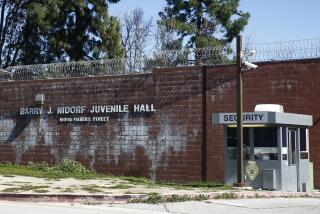Child Abuse Prevention Efforts Seen Ineffective
- Share via
BERKELEY — Child abuse prevention programs for preschool children are having little impact and should be phased out, according to a report released Tuesday by a UC Berkeley research group.
Money spent on programs to train these children should go instead to increased training for parents and teachers on how to spot signs of child abuse, according to the two-year study by researchers at the university’s School of Social Welfare.
The study surveyed 118 preschoolers in seven child abuse programs around the state, including ones in Los Angeles and San Francisco counties. The children, ages 3 1/2 to 5, were asked questions by researchers before and after they were given child abuse training and compared to a control group that did not receive the training.
Researchers found that the children were too young to understand the concepts they were being taught, such as the difference between a “good touch” and a “bad touch.”
“The central idea of training the children bears rethinking,” said Neil Gilbert, a UC Berkeley professor of social welfare and head of the study sponsored by the National Center on Child Abuse. “We should not make 4-year-olds responsible for defending themselves.”
Programs to train preschool children about how to resist sexual abuse have expanded across the nation in recent years, following highly publicized child abuse cases such as the one involving McMartin Pre-School in Manhattan Beach. The case against McMartin teachers Raymond Buckey and his mother, Peggy McMartin Buckey, hinges on the whether the jury believes children’s accounts of having been molested at the nursery school.
The state’s child abuse prevention program provides instruction to about 42,000 preschool children each year. A 1985 bill by Assemblywoman Maxine Waters, (D-Los Angeles), requires all publicly funded preschools, junior high schools and high schools in the state to offer the training. The program’s budget for the current fiscal year is $10.4 million.
Jill Duerr-Berrick, a graduate student who worked on the study, said that although older children seemed to benefit from training, children younger than 6 are not intellectually ready to judge the difference between acceptable and unacceptable treatment.
Preschool children understand the world in “black-and-white, right-and-wrong terms,” Duerr-Berrick said. “They have a lot of trouble understanding the gray areas.
“They can certainly sense extremes. They know a spanking hurts and that a hug is generally good. But . . . they can’t make (fine) distinctions,” she said.
Duerr-Berrick said, for example, that children might not be able to differentiate between “grandma’s yucky kiss and sexual abuse.”
Pnina Tobin, director of the Children’s Self-Help Project in San Francisco, which was studied by the Berkeley team, called the findings and recommendations “totally outrageous.”
She said her program has worked with child care experts to simplify concepts in the training program to a level that children can understand. Kids are told about a full range of touching behavior and where their private parts are. “The important thing is to plant the seed (of knowledge about sexual abuse) at a young age,” she said.
While favoring increased instruction of parents, Tobin said relying on parents to be the sole instructors of their children in this area is a flawed approach.
“If you only educate parents, what if they’re uncomfortable and can’t transmit information to their children? And what if they are offenders themselves? That’s quite possible,” she said.
Duerr-Berrick acknowledged that parental education poses problems. She said, for example, that of the 117 parents involved in the study, only 33 were able to attend meetings about child abuse.
Different approaches to parental education, including televised campaigns or bringing advice about abuse to the workplace through workshops, should be considered, Duerr-Berrick Zsaid.
“Rather than taking the parent to the program,” the program should come to the parent’s workplace, she said.
More to Read
Sign up for Essential California
The most important California stories and recommendations in your inbox every morning.
You may occasionally receive promotional content from the Los Angeles Times.













